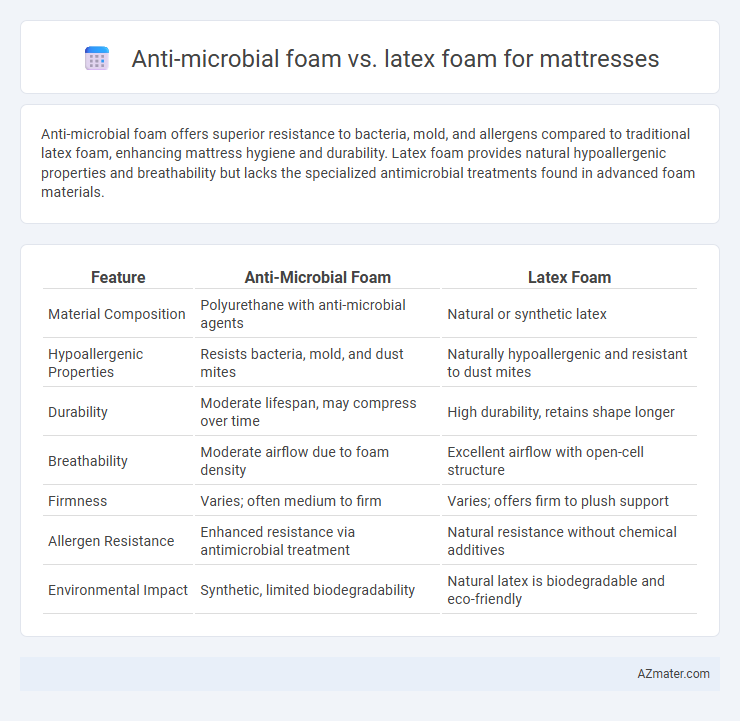Anti-microbial foam offers superior resistance to bacteria, mold, and allergens compared to traditional latex foam, enhancing mattress hygiene and durability. Latex foam provides natural hypoallergenic properties and breathability but lacks the specialized antimicrobial treatments found in advanced foam materials.
Table of Comparison
| Feature | Anti-Microbial Foam | Latex Foam |
|---|---|---|
| Material Composition | Polyurethane with anti-microbial agents | Natural or synthetic latex |
| Hypoallergenic Properties | Resists bacteria, mold, and dust mites | Naturally hypoallergenic and resistant to dust mites |
| Durability | Moderate lifespan, may compress over time | High durability, retains shape longer |
| Breathability | Moderate airflow due to foam density | Excellent airflow with open-cell structure |
| Firmness | Varies; often medium to firm | Varies; offers firm to plush support |
| Allergen Resistance | Enhanced resistance via antimicrobial treatment | Natural resistance without chemical additives |
| Environmental Impact | Synthetic, limited biodegradability | Natural latex is biodegradable and eco-friendly |
Introduction to Mattress Foams: Anti-Microbial vs Latex
Anti-microbial foam mattresses incorporate specialized agents that inhibit the growth of bacteria, mold, and allergens, enhancing hygiene and reducing odor. Latex foam mattresses, derived from natural or synthetic rubber, offer durable support, resilience, and hypoallergenic properties that naturally resist dust mites and mildew. Choosing between anti-microbial and latex foam depends on individual preferences for allergen control, durability, and eco-friendly materials.
Composition and Manufacturing Differences
Anti-microbial foam mattresses incorporate specialized additives such as silver ions or organic biocides into polyurethane or memory foam during manufacturing to inhibit bacterial and fungal growth, enhancing hygiene and durability. Latex foam, derived from natural rubber sap or synthetic materials, undergoes a vulcanization process that solidifies the foam's matrix, inherently resisting microbial activity without additional chemical treatments. The key manufacturing difference lies in the integration of antimicrobial agents within foam polymers for anti-microbial options, whereas latex foam achieves resilience and natural microbial resistance through its organic or synthetic rubber composition and curing process.
Anti-Microbial Properties: Effectiveness and Longevity
Anti-microbial foam in mattresses contains silver ions or other biocidal agents that inhibit bacterial, mold, and dust mite growth, providing enhanced hygiene compared to traditional latex foam. The embedded anti-microbial treatments in these foams maintain their efficacy over time, resisting microbial buildup for several years without diminishing. Latex foam naturally resists some microbial activity due to its organic composition but lacks the specialized, long-lasting anti-microbial protection found in treated foams.
Natural vs Synthetic: Material Origins
Anti-microbial foam typically originates from synthetic polymers infused with antimicrobial agents to inhibit bacteria and mold growth, offering a hygienic sleep surface. Latex foam is derived naturally from rubber tree sap, making it a renewable and biodegradable option favored for its eco-friendly and hypoallergenic properties. Choosing between them depends on prioritizing natural material benefits versus enhanced antimicrobial performance in synthetic foams.
Comfort and Support Comparison
Anti-microbial foam offers enhanced hygiene by inhibiting bacterial growth while providing medium to firm support that adapts to body contours for pressure relief. Latex foam delivers superior elasticity and responsiveness, ensuring consistent support and breathability, which promotes cooler sleep and durable comfort. Both foams provide comfort, with anti-microbial foam emphasizing cleanliness and latex foam excelling in natural support and temperature regulation.
Hypoallergenic Benefits and Allergen Control
Anti-microbial foam mattress offers superior hypoallergenic benefits compared to latex foam by inhibiting the growth of bacteria, mold, and dust mites, which are common allergens. Latex foam, while naturally resistant to dust mites, may not provide the same level of antimicrobial protection, potentially allowing allergens to accumulate over time. For individuals with asthma or severe allergies, anti-microbial foam mattresses deliver enhanced allergen control and create a cleaner, healthier sleep environment.
Durability and Lifespan Analysis
Anti-microbial foam mattresses offer enhanced resistance to bacteria, mold, and allergens, which significantly contributes to their durability by preventing material degradation over time. Latex foam, known for its natural elasticity and resilience, typically provides a longer lifespan--often exceeding 10 years--due to its ability to maintain shape and support without sagging. Comparing the two, anti-microbial foam enhances hygiene-related longevity, while latex foam excels in structural durability and overall lifespan.
Environmental Impact and Sustainability
Anti-microbial foam mattresses offer enhanced resistance to bacteria and allergens but often contain synthetic chemicals that can hinder biodegradability and increase environmental pollution. Latex foam, particularly natural or organic latex, is derived from renewable rubber tree sap, making it more sustainable and biodegradable, with a lower carbon footprint during production. Choosing natural latex foam supports eco-friendly practices, reducing harmful chemical use and promoting long-term environmental health.
Price Comparison and Market Trends
Anti-microbial foam mattresses typically have a higher price point than latex foam due to their specialized antimicrobial treatments that enhance hygiene and reduce allergens. Market trends indicate a growing demand for antimicrobial foam in health-conscious consumer segments, though latex foam maintains strong popularity for its natural, hypoallergenic properties and eco-friendliness. Price comparisons reveal latex foam offers a more affordable option on average, while antimicrobial foam appeals to premium buyers seeking advanced sleep health benefits.
Choosing the Best Foam for Your Mattress Needs
Anti-microbial foam offers enhanced resistance to bacteria, mold, and allergens, making it an ideal choice for allergy sufferers and those seeking a hygienic sleeping surface. Latex foam provides natural breathability, durability, and responsive support, which benefits individuals needing pressure relief and temperature regulation. Selecting the best foam for your mattress depends on prioritizing antimicrobial protection for a cleaner sleep environment or opting for latex's eco-friendly and supportive properties for long-term comfort.

Infographic: Anti-microbial foam vs Latex foam for Mattress
 azmater.com
azmater.com